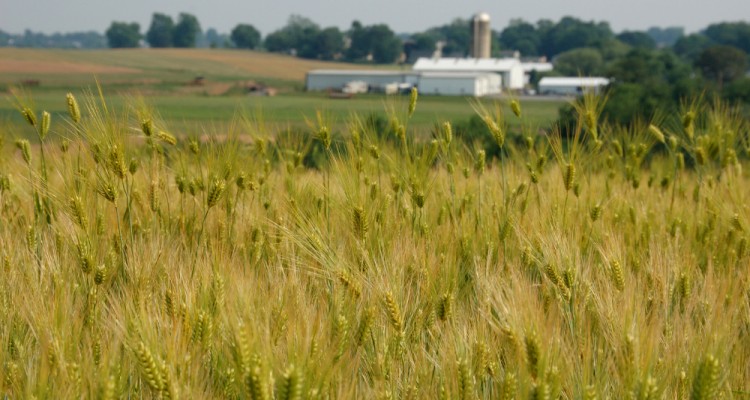The Idyllic Setting
I spent half my life living in rural Lancaster County Pennsylvania on a farm my paternal grandparents purchased when they left the suburbs of New York City in the ‘70s to return to their roots. They spent many years fixing up the farm, and they are now buried a half mile down the road. My family and I moved here after they passed.
Every year, our neighbors, an elderly Mennonite couple from a small farm nearby visit the Sunday after Christmas. They come, bearing the most delicious spread of cookies I’ve ever encountered, to discuss practical topics that are foreign to me such as how to best keep the brush around the edge of a hay field down and how the walnut crop was this year.
Sounds idyllic, no?
But what if in this idyllic setting, and identical ones across the United States, people are being poisoned by farming; the very livelihood on which the community is based? Our neighbor suffers from worsening Parkinson’s Disease, a condition that threatens his work and his farm. Increasingly, evidence suggests that exposure to chemicals found in pesticides and fertilizers (both heavily used on farms) may be one of the primary risk factors for Parkinson’s Disease. This raises a host of questions about how what we do to our environment, and to our food, in the name of progress and efficiency may be affecting the health of the population in unforeseen ways. Most importantly, these findings suggest that going organic may be a remedy to what ails our brains.
The Terrible Disease
Parkinson’s Disease (PD) is a neurodegenerative disease characterized by 1) tremor (trembling in hands, arms, legs, jaw and face); 2) rigidity (stiffness of the limbs or trunk); 3) bradykinesia (slowness of movement); and 4) postural instability (impaired balance and coordination). The disease also results in gait dysfunction, loss of balance, difficulties swallowing and speaking, autonomic disturbances and cognitive decline, progressing in later stages to dementia. This conglomeration of symptoms was first identified by James Parkinson in 1817 in An Essay on the Shaking Palsy. Today, the symptoms he observed are attributed to loss of dopaminergic neurons (a type of neuron best known for being involved in identification of “rewards”) in the substantia nigra pars compacta. Signals from dopaminergic neurons are also crucial to the function of the basal ganglia, an area of the brain critical for the initiation and execution of movements. The loss of dopaminergic signals to this area of the brain results in the movement irregularities seen in PD.
Basal Ganglia and associated structures depicted
While most cases of PD are sporadic (arising without known cause), studying genetic mutations in hereditary (also referred to as “ familial”) cases has yielded insight to the mechanism of action behind the cell loss. One genetic mutation resulting in familial Parkinson’s Disease is in the alpha-synuclein gene. Alpha-synuclein is a protein that enables neurons to communicate with one another at their junctions (called synapses), and is required for normal cognition in mice.
The overexpression of alpha-synuclein produces the most recognized hallmark of PD: Lewy bodies (LBs). Lewy bodies, clusters of alpha-synuclein and other proteins such as ubiquitin (a marker attached to proteins marked for degradation), are the primary markers used to diagnose PD. These markers are used as a metric on the Braak scale, the primary tool used for characterizing the severity of PD. It is now commonly believed that Lewy bodies actually protect against cell death by aggregating harmful proteins to clusters where they are less able to exert an effect (such as cell death). As PD progresses, LBs gradually spread from the diseased basal ganglia into medial temporal lobe (an area where long-term memories form) and neocortex (an area responsible for many aspects of cognition, from visual perception to executive function). As progression occurs to these brain areas, patients can suffer from hallucinations and dementia.
Current treatment for PD focuses on compensating for the lack of dopamine in the basal ganglia. Levodopa, a common treatment, is a precursor of dopamine that is capable of passing the blood brain barrier and being converted to dopamine in the brain. Unfortunately, this is only a temporary band-aid to the problem: Levodopa does not target the underlying mechanisms contributing to cytotoxicity, which occur not only in the dopaminergic neurons, but, in later stages of the disease, in neurons throughout the brain.
The Purported Culprit
Many factors are associated with PD risk, including age, gender (males are more susceptible), and genetics. It was not until 1983 that a link between Parkinson’s Disease and chemical exposure arose. When a group of young people contracted PD-like symptoms after taking a drug containing methyl-phenyl-tetrahydopyridine (MPTP), which is structurally similar to the herbicide paraquat and the pesticide rotenone , they were treated with Levodopa. When their symptoms abated, the first evidence that pesticides might cause Parkinson’s disease was observed.
Since then, many research studies have examined the relationship between pesticide exposure and Parkinson’s Disease. Dr. Beate Ritz at UCLA was one of the first to study this relationship. Her initial study found that PD was listed as the primary cause of mortality 19-47% more often in counties in California that used agricultural pesticides than by those that did not. A later study by another group, piggy-backing on a Cancer Prevention Study, found that people who were exposed to pesticides/herbicides had a 70% higher chance of developing PD. A third (and most recent) study used Medicare data on 450,000 PD cases per year to map PD by race, age, sex and county. The findings show greater prevalence of the disease in the Midwest and Northeast, which led the authors to postulate that chemicals used in industrial processes may be risk factors as well. The analysis in this study could prove useful for epidemiological studies comparing incidence of PD to pesticide regulation and use.
The Possible Mechanism
The precise mechanisms accounting for the symptoms of PD are not perfectly understood, and it is even possible the specific, molecular causes vary from patient to patient. Yet, there is conclusive evidence to suggest that at its root, familial and sporadic PD are both caused by abnormalities in how neurons produce energy. The consequence of inadequate energy production is ultimately cell death.
The human brain constitutes 2% of a person’s body weight but consumes about 20% of the body’s energy in the form of adenosine triphosphate, better known as ATP. Critical to the production and maintenance of ATP are mitochondria, membrane bound organelles found in most eukaryotic cells, including neurons. The process by which ATP is produced in mitochondria, commonly referred to as the cellular respiration, requires oxygen to donate electrons to key players of the cycle. The donation of electrons is necessary to order to maintain levels of ATP adequate for cells to perform their functions.
Mitochonchrion depicted
The breakdown of dopamine produces many reactive oxygen species: molecules containing oxygen with no free electrons. An excess of reactive oxygen species could halt the mitochondrial respiratory cycle. Because of this, dopaminergic neurons may be more susceptible than other neurons to similar levels of mitochondrial dysfunction, which may explain why PD symptoms first arise in dopaminergic areas of the brain.
Many of the genes involved in familial Parkinson’s cases are associated with, or affected by, mitochondrial function. For instance, the amount of alpha-synuclein protein, which aggregates to form Lewy bodies and is mutated many familial cases of PD, increases in response to mitochondrial dysfunction under non-disease conditions. This suggests that sporadic cases of PD arise from failure of mitochondrial function (due to environmental factors) and its resulting downstream effects (e.g. protein aggregates). Rotenone, a pesticide similar in structure to MPTP, inhibits mitochondrial Complex I, the first enzyme in the mitochondrial respiratory chain. Thus, the effects of rotenone on alpha-synuclein levels mimics the effects caused by the genetic mutation in familial PD. Ultimately, the link between pesticides and PD is likely related to the fact that pesticides disrupt energy production and, thus, cellular health.
Pesticides like rotenone have similar effects in the brain to excess nitric oxide (an important signalling molecule); nitric oxide has also been shown to inhibit mitochondrial Complex I. When cells are exposed to NO, proteins are modified in ways that impact the function of other genes mutated in familial cases of PD. The specific mechanistic pathway by which rotenone, and similar pesticides, act in the brain could have intermediate steps (such as the overproduction of NO) which need further parsing.
The Costly Result
Parkinson’s Disease is devastating for patients and their caregivers. In the United States, about 1 million people live with Parkinson’s disease and 60,000 are diagnosed each year; an estimated 10 million people suffer from the disease worldwide. This disease also takes a huge financial toll: In 2010, medical care for PD in the United States cost $14.4 million, or roughly $22,800 per patient. Another $6.3 billion ($10,000 per patient) was estimated as having been lost on the basis of reduced work by patients. As the average age of the population increases, the total cost to society is predicted to grow. Given that PD is not the only condition linked to pesticide exposure (cancer and neurodevelopmental disorders may also be related), the total cost to society of using pesticides is even greater than the numbers listed here. In light of the money spent on care, the $135 million the NIH spends on research for the prevention and treatment of PD is a drop in the bucket.
The Elusive Remedy
Am I at risk for contracting Parkinson’s Disease later in life because I spent my youth roaming the outdoors in a hearty farming community in small-town Americana? Probably. There may be factors that prevent PD, like coffee drinking and nicotine use (in fact, ease of quitting smoking is well correlated with progression of PD). I haven’t started smoking yet (lung cancer is still a deterrent), but coffee is my lifeblood, and I can take solace in my caffeinated state, though even the amount I ingest is likely insufficient to counter the influence of pesticide exposure.
For those who don’t smoke or drink coffee in excessive amounts and are exposed to toxins by their livelihood or the location of their home, should something change?
As scientists, we seek to understand how the brain works and hope that this information can ultimately help save lives as well as increase the general body of knowledge. But too often researchers look for innate or hereditary causes for disease and overlook environmental factors. One extreme example comes from a sad story about “Navajo Neuropathy,” a supposed genetic birth defect caused by inbreeding. It was ultimately determined that this disease was caused not by inbreeding, but by in utero exposure to uranium-contaminated water. In many ways, the story outlined here about Parkinson’s Disease, and potentially other diseases of the brain, is similar. We seek to understand and explain diseases so we can treat them, but focusing our efforts on determining (and eradicating) the things that cause disease is as important for public health in the long term as finding treatments for those who suffer.
Even if the solution to eliminating, or at least abating, sporadic Parkinson’s Disease seems evident, many barriers exist to changing the status quo of pesticide use, and make such a change challenging. Is it possible to grow enough food to feed a nation if we don’t use modern technologies like pesticides and herbicides? How can we help the organic movement grow and win when buying inorganic is always cheaper? How do we increase the demand for pesticide-free foods? If the use of pesticides and herbicides can be conclusively linked to a public health burden, is taxing its use via the food products it supports a reasonable solution? Cigarette taxes, for example, have been in place for many years and increasing the tax on cigarettes has reportedly deterred teenage smokers. In 2009, Obama approved a $0.62 increase in the federal cigarette tax. The money collected from the tax increase was designated for the Children’s Health Insurance Program (CHIP). Could a similar tax program fund research for the treatment and elimination of Parkinson’s Disease? A tax of on foods grown with pesticides might offset the current demand for non-organically grown (read: cheap) foods. With policies like this, or even government subsidies for organic farming, farmers may have be encouraged to move away from using pesticides and try farming organically. Organic produce might then be less costly for consumers. Such a collective change, had it come sooner, might have saved our neighbor from a horrible disease that impacts his family, farm and community.
Whatever your political views or feelings on how we should handle such large scale public health issues, the next time you shop for produce, remember that organic fruit could be good for yours—and the farmer’s—brain.
Further Reading
- “NINDS Parkinson’s Disease Information Page.” NINDS.
- Obeso et al. “Missing pieces in the Parkinson’s disease puzzle”. Nature.
- Shulman et al. “Parkinson’s Disease: Genetics and Pathogenesis.” Annual Review of Pathology, 2010.
- Burre et al. “α-Synuclein promotes SNARE-Complex assembly in vivo and in vitro.” Science.
- Cooper et al. “α-Synuclein blocks ER-Golgi traffic and Rab1 rescues neuron loss in Parkinson’s models.” Science,
- Kokhan et al. “α-Synuclein knockout mice have cognitive impairments.” Behavioral Brain Research,
- Tanaka et al. “Aggresomes formed by α-Synuclein and Synphilin-1 are cytoprotective.” The Journal of Biological Chemistry,
- “Carbidopa/levodopa.” National Parkinson Foundation.
- Van Den Eeden et al. “Incidence of Parkinson’s Disease: Variation by Age, Gender, and Race/Ethnicity.” American Journal of Epidemiology.
- Couteur et al. “Pesticides and Parkinson’s disease.” Biomedicine and Pharmacotherapy.
- Ritz & Yu. “Parkinson’s disease mortality and pesticide exposure in California 1984-1994.” International Epidemiological Association.
- Ascherio et al. “Pesticide exposure and risk of Parkinson’s Disease.” Annuals of Neurology.
- Willis, et al. “Geographic and ethnic variation in Parkinson Disease: A Population-Based Study of US Medicare beneficiaries.” Neuroepidemiology.
- Meiser et al. “Complexity of dopamine metabolism.” Cell Communication and Signaling, 23683503.
- Betarbet et al. “Chronic systemic pesticide exposure reproduces features Parkinson’s disease.” Nature Neuroscience.
- Beltran et al. “Oxidative stress and S-nitrosylation of proteins in cells.” British Journal of Pharmacology.
- Yao et al. “Nitrosative stress linked to sporadic Parkinson’s disease: S-nitrosylation of parkin regulates its E3 ubiquitin ligase activity.” Proceedings of the National Academy of Sciences.
- “Statistics on Parkinson’s.” Parkinson Disease Foundation.
- Kowal et al. “The current and projected economic burden of Parkinson’s disease in the United States.” Movement Disorders.
- Deng et al. “Rotenone induces apoptosis in MCF-7 human breast cancepr cell-mediated ROS through JNK and p83 signaling.” Molecular Carcinogenesis.
- Shelton et al. “Neurodevelopmental Disorders and Prenatal Residential Proximity to Agricultural Pesticides: The CHARGE Study.” Environmental Health Perspective.
- “Parkinson’s Disease Research Web Overview.” NINDS.
- Costa et al. “Caffeine exposure and the risk of Parkinson’s Disease: A systemic review and meta-analysis of observations.” Journal of Alzheimer’s Disease.
- Quik et al. “Multiple roles for nicotine in Parkinson’s disease.” Biochemical Pharmocology.
- Ritz et al. “Parkinson disease and smoking revisited: ease of quitting is an early sign of the disease.” Neurology.
- “Oases in Navajo desert contained ‘a witch’s brew’.” Los Angeles Times.
- “President Obama signs children’s health insurance and tobacco tax increase into law.” Medical News Today.
Image Credit: Wikipedia








